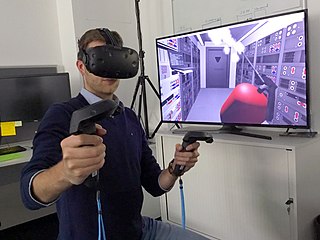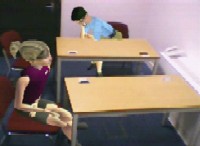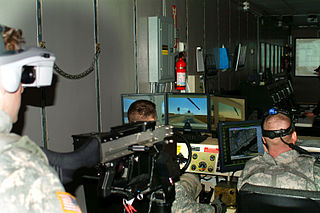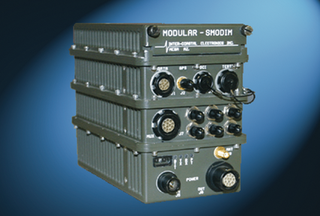Related Research Articles

Virtual reality (VR) is a simulated experience that can be similar to or completely different from the real world. Applications of virtual reality can include entertainment and educational purposes. Other, distinct types of VR style technology include augmented reality and mixed reality.

Mixed reality (MR) is the merging of real and virtual worlds to produce new environments and visualizations, where physical and digital objects co-exist and interact in real time. Mixed reality does not exclusively take place in either the physical or virtual world, but is a hybrid of reality and virtual reality, encompassing both augmented reality and augmented virtuality via immersive technology.
Marine Doom is a 1996 modification of the first-person shooter Doom II for the United States Marine Corps, which was later made available for download to the public.

Established 1 July 1973, the United States Army Training and Doctrine Command (TRADOC) is a major command of the United States Army headquartered at Fort Eustis, Virginia. It is charged with overseeing training of Army forces and the development of operational doctrine. TRADOC operates 37 schools and centers at 27 different locations. TRADOC schools conduct 1,304 courses and 108 language courses. The 1,304 courses include 516,000 seats for 443,231 soldiers; 36,145 other-service personnel; 8,314 international soldiers; and 28,310 civilians.
VBS1 is a military simulator which relies heavily on modern game technology and is therefore generally referred to as a serious game. The platform is derived from the first-person entertainment game Operation Flashpoint and is developed by Bohemia Interactive Australia. The system enables the practice of small unit military tactics in an interactive multiplayer 3D environment. The platform provides real-time scenario management facilities, customized vehicles and equipment, user-definable mission scenarios, and variable environmental conditions. This combination of military simulator functionality and modern gaming technology proved to be a success and resulted in a broad military customer base. VBS2 is the successor of this platform.

The Institute for Creative Technologies (ICT) is a research institute of the University of Southern California located in Playa Vista, California. ICT was established in 1999 with funding from the US Army.
Under direction of the Office of Naval Research, the Naval Research Laboratory’s Code 5770 produced the SIMDIS 3-D Analysis and Display Toolset to the US Department of Defense community. SIMDIS provides support for analysis and display of test and training mission data to more than 4000 users. SIMDIS runs on Windows, Linux, and Sun Microsystems workstations with hardware accelerated 3-D graphics and provides identical execution and "look and feel" for all supported platforms. Since SIMDIS requires no additional COTS products or license fees, the Range Commanders Council (RCC) currently lists SIMDIS as a cost savings/avoidance program for the US Department of Defense.
Virtual Heroes, Inc. is a developer of serious games in Raleigh, North Carolina, United States. It was founded in 2004.

The U.S. Army Combined Arms Center (USACAC) is located at Fort Leavenworth and provides leadership and supervision for leader development and professional military and civilian education; institutional and collective training; functional training; training support; battle command; doctrine; lessons learned and specified areas the Commanding General, United States Army Training and Doctrine Command (TRADOC) designates in order to serve as a catalyst for change and to support developing relevant and ready expeditionary land formations with campaign qualities in support of the joint force commander.

DARWARS was a research program at DARPA intended to accelerate the development and deployment of military training systems. These are envisioned as low-cost, mobile, web-centric, simulation-based, “lightweight” systems designed to take advantage of the ubiquitous presence of the PC and of new technology, including multi-player games, virtual worlds, off-the-shelf PC simulations, intelligent agents, and on-line communities. The project started in 2003 under the leadership of DARPA Program Manager Dr. Ralph Chatham, a former U.S. Navy officer.
AVCATT is a mobile aviation training simulator developed by L-3 Communications, Link Simulation & Training for the United States Army.
A Dynamic terrain is the representation of terrain together with the capability for modification during a simulation.
Live, Virtual, & Constructive (LVC) Simulation is a broadly used taxonomy for classifying Models and Simulation (M&S). However, categorizing a simulation as a live, virtual, or constructive environment is problematic since there is no clear division between these categories. The degree of human participation in a simulation is infinitely variable, as is the degree of equipment realism. The categorization of simulations also lacks a category for simulated people working real equipment.

The United States Army Simulation and Training Technology Center (STTC) provides the United States Department of Defense and United States Department of Homeland Security with applied research to develop simulation technologies, build on current simulation knowledge, and understand system of systems environments where human, agent, and teams are involved.
The virtual world framework (VWF) is a means to connect robust 3D, immersive, entities with other entities, virtual worlds, content and users via web browsers. It provides the ability for client-server programs to be delivered in a lightweight manner via web browsers, and provides synchronization for multiple users to interact with common objects and environments. For example, using VWF, a developer can take video lesson plans, component objects and avatars and successfully insert them into an existing virtual or created landscape, interacting with the native objects and users via a VWF interface.
Military Open Simulator Enterprise Strategy (MOSES) is a U.S. Army project evaluating the ability of OpenSimulator to provide independent and secured access to a virtual world.
Pointman is a seated user interface for controlling one's avatar in a 3D virtual environment. It combines head tracking, a gamepad, and sliding foot pedals to provide positional control over many aspects of the avatar's posture. Pointman was developed by the US Naval Research Laboratory (NRL) to support the use of dismounted infantry simulation for USMC training and mission rehearsal. NRL's goal in developing Pointman was to extend the range and precision of actions supported by virtual simulators, to better represent what infantrymen can do.

The Smart Onboard Data Interface Module (SMODIM) is used by the United States Army and foreign militaries for live simulated weapons training on military platforms. The SMODIM is the primary component of the Longbow Apache Tactical Engagement Simulation System that provides weapons systems training and collective Force-on-Force live training participation.

Virtual reality applications are applications that make use of virtual reality (VR). VR is an immersive sensory experience that digitally simulates a remote environment. Applications have been developed in a variety of domains, such as education, architectural and urban design, digital marketing and activism, engineering and robotics, entertainment, fine arts, healthcare and clinical therapies, heritage and archaeology, occupational safety, social science and psychology.
The Augmented Reality Sandtable (ARES) is an interactive, digital sand table that uses augmented reality (AR) technology to create a 3D battlespace map. It was developed by the Human Research and Engineering Directorate (HRED) at the Army Research Laboratory (ARL) to combine the positive aspects of traditional military sand tables with the latest digital technologies to better support soldier training and offer new possibilities of learning. It uses a projector to display a topographical map on top of the sand in a regular sandbox as well as a motion sensor that keeps track of changes in the layout of the sand to appropriately adjust the computer-generated terrain display.
References
- ↑ Stand-To! The Official Focus of The U.S. Army. "Virtual Battlespace 3". army.mil. U.S. Army. Retrieved July 16, 2018.
- ↑ Bohemia Interactive Simulations. "Bohemia Interactive Simulations Awarded U.S. Marine Corps Contract" (PDF). bisimulations.com. Bohemia Interactive Simulations. Retrieved 16 July 2018.
- ↑ Aishwarya, Srivari. "UK MoD to use VBS3 software to train soldiers in virtual environment". army-technology.com. Verdict Media Ltd. Retrieved July 16, 2018.
- ↑ Bohemia Interactive Simulations. "BISIM RELEASES LATEST UPDATES TO VBS3, VBS CONTROL BEHAVIOR PACK 1, AND VBS SIMULATION SDK". bisimulations.com. Bohemia Interactive Simulations. Retrieved July 13, 2018.
- ↑ Shephard News Team. "BISim released updated VBS3 versions". shephardmedia.com. Retrieved July 13, 2018.
- ↑ US military looking for better video game training technology, Polygon
- ↑ Military upgrade: A look at Bohemia’s revamped soldier-training simulator, Orlando Business Journal
- ↑ Army’s new training shooter makes out of shape soldiers look fat, Ars Technica
- ↑ Stand-To! The Official Focus of the U.S. Army. "Virtual Battlespace 3". army.mil. U.S. Army. Retrieved July 16, 2018.
- ↑ Barrie, Alison. "Army battles with brawn and beer bellies". foxnews.com. Fox News. Retrieved 3 March 2015.
- ↑ "STAND-TO!". www.army.mil. Retrieved 2018-08-22.
- ↑ U.S. Army TRADOC. "Gaming is serious business: VBS3 TRADOC Now!". Gaming is serious business: VBS3 TRADOC Now!. U.S. Army. Retrieved 12 January 2015.
- 1 2 "Virtual Battlespace 3". army.mil. U.S. Army. Retrieved 3 March 2015.
- ↑ South, Todd. "See how this virtual reality trainer can help paratroopers do mission planning". armytimes.com. Sightline Media Group. Retrieved July 16, 2018.
- ↑ Meggitt Training Systems. "FATS100MIL small arms trainer". meggitttrainingsystems.com. Meggitt Training Systems. Retrieved July 16, 2018.
- ↑ Military Simulation and Training Magazine. "U.S. Air Force to use VBS3 to approach unmanned aircraft training". militarysimulation.training. Halldale Group. Retrieved July 16, 2018.
- ↑ Jones, Ted; Moore, Todd; Choo, James (2016-12-20). "The Impact of Virtual Reality on Chronic Pain". PLOS ONE. 11 (12): e0167523. Bibcode:2016PLoSO..1167523J. doi:10.1371/journal.pone.0167523. ISSN 1932-6203. PMC 5172565 . PMID 27997539.
- ↑ Bohemia Interactive Simulations. "VBS3 Fact Sheet" (PDF). bisimulations.com. Bohemia Interactive Simulations. Retrieved 12 January 2015.
- ↑ CURTHOYS, KATHLEEN. "Personalized Approach to Army Avatars". defensenews.com. Defense News. Retrieved 3 March 2015.
- 1 2 3 4 5 Bohemia Interactive Simulations. "Technology". bisimulations.com. Bohemia Interactive Simulations. Retrieved 12 January 2015.
- ↑ http://www.foxnews.com/tech/2014/05/22/army-battles-with-brawn-and-beer-bellies/
- 1 2 Bohemia Interactive Simulations. "New Developments in VBS3 – GameTech 2014" (PDF). bisimulations.com. Bohemia Interactive Simulations. Retrieved 12 January 2015.
- ↑ RealWire. "VBS3 v3.9.2 Supports New Prototype Oculus Rift CV1 and HTC Vive Integrations". realwire.com. RealWire. Retrieved 13 July 2018.
- ↑ Bohemia Interactive Simulations. "VBS Expands Support for VR". bisimulations.com. Bohemia Interactive Simulations. Retrieved 13 July 2018.